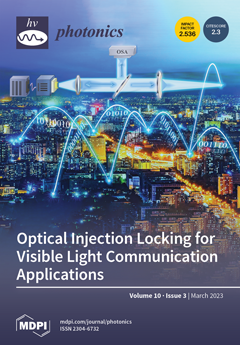Open AccessArticle
Lensed Fiber-Optic Two-Photon Endomicroscopy for Field-of-View Enhancement
by
Conghao Wang, Huilan Liu, Jianrui Ma, Qiang Fu, Yijun Li, Yanchuan Chen, Yuqian Gao, Jingquan Tian, Xinlei Luo, Fei Yu, Chunzhu Zhao, Runlong Wu, Aimin Wang and Lishuang Feng
Cited by 2 | Viewed by 1556
Abstract
Two-photon endomicroscopy is a promising technique with the ability to achieve in situ imaging and diagnosis at subcellular resolution. The large field-of-view capability is essential and useful to locate and image suspicious areas of biological tissue. In this work, we report objective-lens-free, lensed
[...] Read more.
Two-photon endomicroscopy is a promising technique with the ability to achieve in situ imaging and diagnosis at subcellular resolution. The large field-of-view capability is essential and useful to locate and image suspicious areas of biological tissue. In this work, we report objective-lens-free, lensed fiber-optic two-photon endomicroscopy for field-of-view enhancement. The field of view of this two-photon endomicroscopic probe is 750 μm with a resolution of 3.03 μm. This 1.6 g miniature probe has an integrated outer diameter of 5.8 mm and a rigid length of 33.5 mm. The imaging performance of the lensed-fiber-optic two-photon endomicroscopy was validated by examining an ex vivo mouse heart, kidney, brain, stomach wall tissues, and in vivo brain tissue.
Full article
►▼
Show Figures





